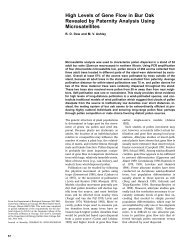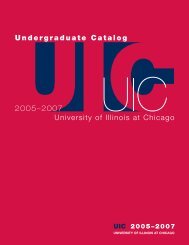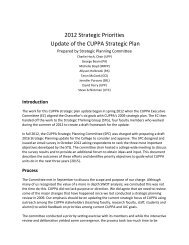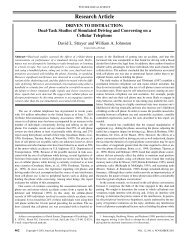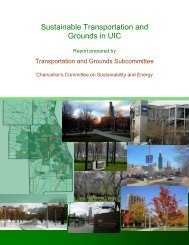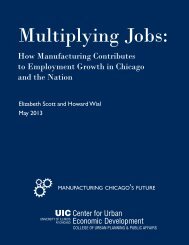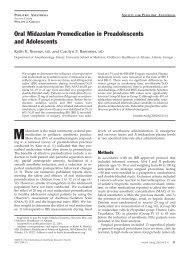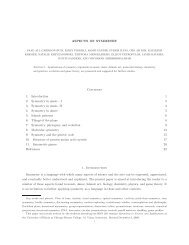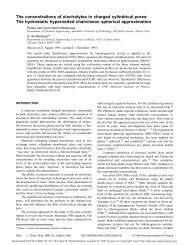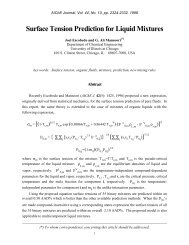Greener Solvent Selection and Solvent Recycling for CO2 Capture
Greener Solvent Selection and Solvent Recycling for CO2 Capture
Greener Solvent Selection and Solvent Recycling for CO2 Capture
You also want an ePaper? Increase the reach of your titles
YUMPU automatically turns print PDFs into web optimized ePapers that Google loves.
<strong>Greener</strong> <strong>Solvent</strong> <strong>Selection</strong> <strong>and</strong> <strong>Solvent</strong> <strong>Recycling</strong> <strong>for</strong> CO 2 <strong>Capture</strong><br />
Economically removing <strong>CO2</strong> from the flue gases of coal-fired power plants would alleviate concerns<br />
about their contribution to global climate change. <strong>CO2</strong> can be removed by several methods including<br />
absorption using solvents, adsorption onto solid sorbents, pressure or temperature swing adsorption,<br />
cryogenic distillation <strong>and</strong> membrane separation. Of these methods absorption by solvents is considered<br />
to be highly promising. Amine solvents are currently used to remove <strong>CO2</strong> from dilute gas streams<br />
because they have very high affinity <strong>for</strong> <strong>CO2</strong>. Un<strong>for</strong>tunately high affinity <strong>for</strong> <strong>CO2</strong> makes solvent recovery<br />
<strong>for</strong> reuse very expensive [1, 2]. This project’s goal is to find new solvents that balance high affinity <strong>for</strong><br />
<strong>CO2</strong> with ease of solvent recovery <strong>and</strong> reuse. Because the number of c<strong>and</strong>idate solvents <strong>and</strong> solvent<br />
blends is very large, a purely experimental search is impossible. In recent years, researchers have<br />
demonstrated the advantage of integrating computational solvent design with computational process<br />
synthesis to guide the experimentation needed to find new solvent absorption processes possessing<br />
good environmental <strong>and</strong> economic per<strong>for</strong>mance[3]. This project presents a coupled solvent selection <strong>and</strong><br />
process synthesis approach to identify a cost-effective, environmentally friendly technology <strong>for</strong> <strong>CO2</strong><br />
capture, separation <strong>and</strong> solvent recovery. Integrating solvent design <strong>and</strong> process synthesis poses the<br />
challenging problems of multiple conflicting objectives, a combinatorial explosion of alternatives, <strong>and</strong><br />
uncertainties arising from thermodynamic model uncertainties, variations in market conditions <strong>and</strong> flue<br />
gas composition. This project will use a combinatorial chemical design algorithm to recommend new<br />
solvents <strong>and</strong> solvent blends <strong>and</strong> a new <strong>and</strong> efficient multiobjective optimization (MOP) framework under<br />
uncertainty[4], coupled with the ASPEN simulator [5], to computationally evaluate solvent c<strong>and</strong>idates.<br />
Only those solvent c<strong>and</strong>idates that have been computationally determined to have promising<br />
per<strong>for</strong>mance will be evaluated further. The goals of the proposed project are presented below.<br />
• Using a multiple objective optimization framework <strong>and</strong> process simulation, identify the target solvent<br />
properties needed <strong>for</strong> optimal economic per<strong>for</strong>mance. Targets <strong>for</strong> chemical stability, health, safety<br />
<strong>and</strong> environmental properties will also be established. Identify the structural groups to be used to<br />
design new solvent molecules. Proper selection of these groups will ensure the design of stable, high<br />
per<strong>for</strong>mance solvents.<br />
• Characterize <strong>and</strong> quantify uncertainties <strong>and</strong> risks in environmental <strong>and</strong> economic impacts,<br />
thermodynamic models, cost models <strong>and</strong> data. Computationally design c<strong>and</strong>idate solvents <strong>and</strong><br />
solvent blends that satisfy the per<strong>for</strong>mance, environmental, health <strong>and</strong> safety targets previously<br />
identified.<br />
• Develop efficient algorithmic framework <strong>for</strong> solvent selection <strong>and</strong> solvent recycling.<br />
• Find multiobjective solvent <strong>and</strong> process designs <strong>for</strong> CO 2 capture (Figure 3).<br />
Figure 3 shows the CO 2 capture <strong>and</strong> solvent recycling absorption distillation process<br />
flowsheet. The solvent recycling consumes tremendous amount of energy <strong>and</strong> other<br />
resources like water.<br />
Specific tasks of the REU fellows include identifying decision variables <strong>for</strong> optimization of solvent<br />
selection <strong>and</strong> solvent recycling system by carrying out simulation runs of ASPEN models <strong>and</strong> using<br />
statistical techniques, underst<strong>and</strong>ing the difference between rate-based models <strong>and</strong> equilibrium models,<br />
identifying optimal solvent blends, <strong>and</strong> writing report. With this project, the REU fellows will be exposed<br />
to various simulation tools, mathematical <strong>and</strong> statistical methods <strong>and</strong> algorithms, <strong>and</strong> physics based<br />
modeling. The REU students activities will be alongside graduate students who are pursuing their PhD
degrees in this area, <strong>and</strong> Post-doctoral fellows. The research contributes to the important area of carbon<br />
capture <strong>and</strong> is likely to be implemented soon in near future.<br />
------------------------------------------------------------------------------------------------------------------------------------------<br />
1. Hanne M. Kvamsdal <strong>and</strong> Gary T. Rochelle (2008), Effects of the temperature bulge in <strong>CO2</strong><br />
absorption from flue gas by aqueous monoethanolamine, Ind. Eng. Chem. Res., 47, 867-875.<br />
2. An<strong>and</strong> B. Rao, Edward S. Rubin, David W. Keith, <strong>and</strong> M. Granger Morgan (2006), Evaluation of<br />
potential cost reductions from improved amine-based <strong>CO2</strong> capture systems, Energy Policy, 34, 3765-<br />
3772<br />
3. Kim K. J. (2001), <strong>Solvent</strong> <strong>Selection</strong> <strong>and</strong> <strong>Solvent</strong> <strong>Recycling</strong>: A Multiobjective Optimization Framwork<br />
under Uncertainty, Ph.D. Thesis, Carnegie Mellon University.<br />
4. Diwekar, U.M. (2008), Introduction to Applied Optimization, 2 nd Edition, Springer.<br />
5. AspenTech (2000), Aspen Plus Documentation Version 10.1-0, AspenTech, Cambridge, MA



